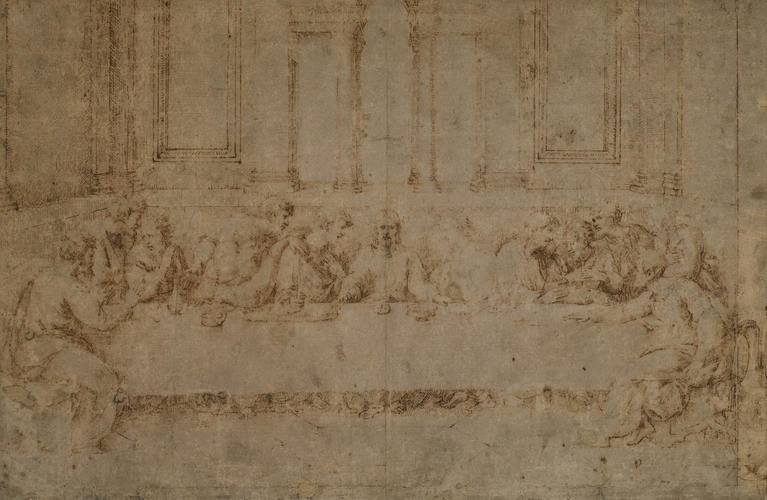-
1 of 253523 objects
The Last Supper c.1514
Pen and ink with stylus lines and pointing; the outlines indented; badly faded, the paper discoloured and abraded. Watermark of an anchor in a circle, surmounted by a 7-point star. | 30.6 x 46.5 cm (sheet of paper) | RCIN 912745

Attributed to Raphael (1483-1520)
The Last Supper c.1514
-
This ruined drawing corresponds closely, in the same direction and on the same scale, with two almost identical engravings, by Marcantonio Raimondi and Marco Dente da Ravenna respectively (Bartsch XIV, p.33, nos. 26-27). Although they are not inscribed as such, these have always been recognised as being after a design by Raphael. The drawing extends a little further than the engravings at the right and below, and fold-lines here correspond with the edges of the composition as engraved. Several drawing-pin holes (most clearly visible at upper right) are symmetrical about the folds, indicating that the sheet was at some stage secured to a surface when folded, defining exactly the area to be engraved; it is thus almost certainly the model used by the engraver.
The main difference between the drawing and the engravings is the still-life at the far left of the table, where a knife disappears and the wine carafe becomes a jug. In Marco Dente's version, light drypoint lines in that area follow the details of the drawing, with the amendments engraved with the burin; Marcantonio’s print has only the engraved amendments. This detail seems to demonstrate that Marco Dente’s version was executed first, working from the drawing, and that Marcantonio's version was copied from Marco Dente's engraving, and not from the drawing (Landau and Parshall, The Renaissance Print, 1994, pp.138-41).
The poor state of the sheet has led many modern scholars to doubt the unanimous nineteenth-century attribution of the drawing to Raphael, and an attribution to his assistant Gianfrancesco Penni is now most common. Photography in ultra-violet light however recaptures much of the intensity of the iron-gall ink, and allows the original strength of the drawing to be seen. While not exuberant or experimental – this would go against the function of the sheet – the draftsmanship is decisive and varied, and the facial types are individually characterized. The architecture is constructed with many stylus lines and compass points: there is a vanishing point visible in the lower part of the central window, well above Christ's head, and although the function of some of the compass points is obscure it is clear that the draftsman was responsible for the invention of the architecture. These considerations alone do not prove that the drawing by Raphael; it could in principle have been a drawing by the engraver on the basis of studies provided by the artist, but it is improbable that Raphael would design the figures only and leave the invention of the architecture to the engraver (or to some assistant). An attribution to Raphael himself seems at least plausible.
The watermark found on the sheet is identical to that found on the study for the Miraculous Draft (RCIN 912749), suggesting a similar date of around 1514, and that is compatible with the compositional and figural style of the Last Supper. Raphael's motivation for designing such a print at a time when he was heavily involved with the tapestry cartoons and the designs for the Stanza dell'Incendio is not known, and the Last Supper cannot be shown to have derived from some abandoned project. (There is no substantial connection with a sketch of the same subject in Vienna that must date from five or so years earlier; Birke and Kertész, Die Italienischen Zeichnungen der Albertina, 1992-97, I, no. 195.)
The sheet's condition, with faded ink, discoloured and dirty paper, insect damage and abrasion to the surface, indicates that it was once framed and displayed for many years, and probably unglazed for much of this time. It might therefore be one of two drawings listed in the 1696 inventory of Palazzo Bonfiglioli in Bologna, the source of a number of old master drawings now in the Royal Collection: ‘Un Dissegno con la Cena di Christo egl'Apostoli di mano di Rafaele in cornice dorata e suo vetro’; or ‘Un dissegno con la Cena di Christo agl'Apostoli similmente di Raffaele con cornice e cassetta dorata, e suo vetro’. No such drawing was described by Jonathan Richardson on his visit to Palazzo Bonfiglioli in 1719 (An Account of some of the Statues..., 1722, pp. 29-32).
Text adapted from M. Clayton, Raphael and his Circle, 1999, no. 29.Provenance
Possibly Bonfiglioli family, Bologna; in which case Zaccaria Sagredo, 1728; from whose heirs bought by Consul Joseph Smith; from whom bought by George III, 1762. Recorded in George III's 'Inventory A', c.1810, p.51, Raffaello d'Urbino e Scuola, no. 41: 'A damaged Drawing, with a pen, of the last Supper, after Raphael.'
-
Creator(s)
-
Medium and techniques
Pen and ink with stylus lines and pointing; the outlines indented; badly faded, the paper discoloured and abraded. Watermark of an anchor in a circle, surmounted by a 7-point star.
Measurements
30.6 x 46.5 cm (sheet of paper)
Other number(s)